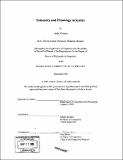Semantics and phonology in syntax
Author(s)
Csirmaz, Aniko
DownloadFull printable version (13.36Mb)
Other Contributors
Massachusetts Institute of Technology. Dept. of Linguistics and Philosophy.
Advisor
Sabine Iatridou.
Terms of use
Metadata
Show full item recordAbstract
In this thesis I argue that morphology should be allowed to interpret not only the information provided by the syntactic component, but also compositional semantic properties. This conception of grammar requires morphology to interact LF and the semantic component in addition to syntax. Applying this hypothesis, I account for the alternation between partitive and non-partitive structural case in Finnish, which is affected by the semantic property of divisibility. I argue that the property of divisibility, which is relevant for case alternation, is determined within Spell-out domains, which are interpreted immediately following Spell-out. Building on these domains as affecting case marking, I derive the differences between divisibility affecting case morphology and the property of divisibility as determined in the final semantic interpretation. I also discuss the properties of negated event predicates in detail, and argue for a specific view of the semantic import of negation on aspect. I show that in spite of the apparent semantic similarities, the effects of negation on Finnish case marking cannot be assimilated to the instances of case alternation determined by divisibility. (cont.) I extend this conclusion and discuss the nature of divisibility licensed by negation crosslinguistically in more detail. Finally, I consider further areas where the interaction between semantics and morphology or the phonological form can be detected. I argue that while some of these interactions can be treated by assuming that the latter components are sensitive to semantic properties, not all interactions can be described this way. In general, however, permitting the interaction between semantics and morphology or phonology is desirable and leads to a more economical system, where the number of non-convergent derivations is minimized.
Description
Thesis (Ph. D.)--Massachusetts Institute of Technology, Dept. of Linguistics and Philosophy, 2005. Includes bibliographical references (p. 235-248).
Date issued
2005Department
Massachusetts Institute of Technology. Department of Linguistics and PhilosophyPublisher
Massachusetts Institute of Technology
Keywords
Linguistics and Philosophy.